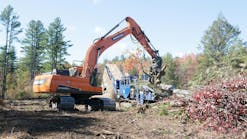First introduced several years ago by Takeuchi and ASV Inc., today rubber-track loaders also are offered by Bobcat, Gehl, and Caterpillar. And New Holland says it is testing and reviewing types of tracks.“Compact track loaders are fairly common in Europe, and they’re becoming more popular in the United States,” says Industry Analyst Frank Manfredi of Manfredi & Associates. “Takeuchi was one of the original companies to sell a tracked loader, and then about 10 years ago ASV was formed. They developed a rubber-track undercarriage and supply it to both Caterpillar and Polaris.”At Takeuchi, Mike Ross says track loaders are a very big growth market in the US. “I think the rubber-track-loader market has grown by 35 a year for the past four years. A lot of people who have been running skid-steers are going to these machines. They’re finding out that a track machine is a lot more productive.” One equipment dealer notes that a compact track loader can replace a small dozer – and is smaller to transport in the bargain. Takeuchi offers three models of rubber-track loaders that range up to 81 hp with a turbocharger.It’s true that track machines are more expensive than skid-steers, says Ross – about $8,000ñ$10,000 more for the same-size machine. “But most operators find that [track-loader] productivity is about double that of a skid-steer. And these track machines are a lot more versatile.”For example, a track loader offers flotation; it can work in muddy areas where a skid-steer can’t go, says Bobcat’s Lance Schulz. Plus, a track loader extends the work season. In northern climates, you can work earlier in a wet spring and later in the fall. “A track loader grades better and has more pushing power than a skid-steer [does],” says Schulz. Today, Bobcat offers four rubber-track models – two with radial-style lifting linkages and two with vertical-lift linkages. Two of the machines are rated at 56 hp, and two have 81 hp.Gehl buys rubber-track loaders from Takeuchi. “We have an agreement for them to build machines for us,” says Gehl’s Kelly Moore. The company offers two track models, one with 66 hp and the other with 97 hp. Both feature radial-style lift arms and were introduced in March 2002.At the same time, Caterpillar introduced its 247 and 257 Multi Terrain Loaders, which feature a rubber-track undercarriage from ASV, a Caterpillar affiliate. Both of these machines use the upper portions of Cat skid-steer loaders. The two machines have operating capacities, respectively, of 1,354 lb. (the 247) and 1,614 lb. (the 257).The company says the new rubber-track undercarriage transfers weight to the ground through 24 wheeled contact points. The rubber track is lightweight and pliable yet is reinforced with high-tensile-strength cords for extra durability. Its edges are beveled to prevent scuffing or damage when used on lawns or turf.Caterpillar also offers two larger models – the 267 and 277 rubber-track loaders. Like the 247 and 257, these models combine a skid-steer upper portion with an undercarriage from ASV. The 267 and 277 have operating capacities of 2,030 lb. and 2,065 lb. The Society of Automotive Engineers defines operating capacity for a track loader as 35% of its maximum tipping load. Wheeled loaders are rated at 50% of the tipping load.ASV recently introduced the RC-100, its newest rubber-track machine. The machine boasts a 99.5-hp Cat engine, a 7,600-lb. tipping load, and a lift height of 125 in. ASV says the Posi-Power Control system makes it virtually impossible to stall the engine because the system automatically shifts the hydrostatic drive to match available horsepower.Skid-Steers Increase WheelbasesThe recent trend in skid-steer loaders is toward larger machines and those with longer wheelbases, according to manufacturers. Longer wheelbases offer a smoother ride, increased stability, and a greater load-carrying capacity. “We’ve heard customers say they like the longer wheelbase,” says Rusty Schaefer at Case Construction Equipment.With all other things being equal, a longer wheelbase will scuff the tires more in a turn. Traditionally, longer wheelbases produce more tire wear, but now, says Schaefer, manufacturers are building tires that last longer. “That allows us to increase the wheelbase without significantly decreasing tire life.”If you hold the width of a skid-steer loader constant, though, there’s a limit to the length of the wheelbase, says Bobcat’s Lynn Roesler. “A machine with a longer wheelbase can require a wider width between the tires if you want to turn it very easily.” Bobcat engineers look at the tread width of the loader – the distance between the centerlines of the right and left tires. Then the engineers consider the tread-widthñto-wheelbase ratio.“If that tread-widthñto-wheelbase ratio were 1.0, the machine would turn hard; your wheelbase would be much too long,” explains Roesler. “It would be doggy in turning and would require a lot of horsepower to turn the machine.” He says many Bobcat skid-steer loaders have a tread-widthñto-wheelbase ratio of around 1.40. The company’s top-selling skid-steer loaders, the S175 and S185, have a 1.38 ratio of tread width to wheelbase. “The lower that ratio is, the more power it will require to turn.”Skid-steers have the ability to counter-rotate or spin about the center of the machine, says John Deere’s Larry Foster. “Thus, the wheelbase can be longer or shorter, but the key dimensions that affect maneuverability are length and width.”“It is worthy to note that from the mid-’80s only John Deere and New Holland had long-wheelbase machines,” says Foster. “Today, however, every manufacturer has long-wheelbase machines. In fact, from the 1,500-lb.-rated operating capacity and up, all of the competitor machines have increased their wheelbases to longer wheelbases like the Deere and New Holland models [have].“John Deere has an exceptionally low center of gravity because we keep all of the heavy components and fluids low in the frame,” continues Foster. “The benefit is superior stability and balance for enhanced load carrying, increased traction, and more stable and safe operation on unlevel terrain.” For the record, the wheelbases on John Deere skid-steers range from 42.3 to 48.6 in.While noting the advantages of a longer wheelbase, Caterpillar points out that a longer wheelbase can cause accelerated tire wear and require more horsepower to turn. Wheelbases on Caterpillar skid-steers range from 39 to 48 in.Pilot Controls?If Caterpillar and John Deere now offer pilot-actuated controls on their backhoe loaders, is that feature available for skid-steer loaders? It’s not a black-and-white issue, but such hand controls generally provide low effort and low travel. It turns out that all 10 Cat skid-steers and all five Multi Terrain Loaders have pilot-operated controls for drive and loader functions. And Takeuchi skid-steers have hand pilot controls (joysticks) for all models of tracked loaders.Not all manufacturers, however, think pilot controls are necessary on skid-steer loaders. “Our control geometry has a very low effort on lever functions,” says Schaefer. “So there’s less value in having pilot controls on our skid-steers because our mechanical controls have low effort.”Bobcat’s skid-steers don’t have pilot controls, but Schulz says the company instead sells a selectable joystick control option. With that, two joysticks feed information to a software program, and the software tells the hydraulic pumps what to do. With the flip of a switch, Bobcat users can change the controls from the International Organization for Standardization pattern (left joystick drives; right joystick is work group) to an H-pattern, with which two joysticks work drive and functions in combination.At John Deere, Foster says all models come standard with foot controls (Bobcat’s standard), and Deere offers hand controls as a factory-installed option on all models. The company’s models 240 through 270 have manual controls, and the Model 280 uses servo controls.Following are some recent product introductions and features from selected skid-steer loader manufacturers:Bobcat In September 2003, Bobcat introduced the T250 compact tracked loader, which has a rated operating capacity of 2,500 lb. To comply with new lean manufacturing initiatives, the company is using the mainframe design of the S220 skid-steer, which has a radius path lift arm configuration. The T250 offers 11% more power, with 81 hp, than the T200 does.Bobcat also offers an all-wheel steer loader, the A300. Especially when used on pavements, the loader saves on tire wear when compared to a skid-steer loader. An example comes from Henry Evans, a construction site cleanup contractor based in Little River, SC. Evans estimates that he gets four to five times more life from the tires on his A300 than from a skid-steer loader’s tires. Along with partner Robert Hughes, Evans owns E&H Site Management Inc. Using the A300, the company loads debris from construction sites into trucks that park on subdivision pavements.Case Construction EquipmentAlong with Bobcat and New Holland, Case is a market share leader in the North American skid-steer loader business. Case recently introduced three new skid-steers: the 40XT, the 60XT, and the 70XT. Those three replaced models 1840 and 1845, says Schaefer. The three new models range in power from 56 net hp to 79 net hp. With these new models, Case boosted the power and lifting capacity of the lower end of the skid-steer line. The upper end of the range encompasses the 75XT, the 85XT, the 90XT, and the 95XT. At the upper end, the 95XT has 85 hp and 3,650 lb. of lifting capacity with counterweight.Because the three smaller machines have radial path lift arms, Case puts hydraulic self-leveling on the buckets to prevent spillage of material. Of the larger models, the 75XT, the 85XT, and the 95XT all have vertical-lift arm linkages so the arms extend outward at the top of the lift. “That’s more important on larger models,” says Schaefer.What’s more, Case offers ride control for skid-steers. Ride control consists of a hydraulic accumulator that cushions the lift cylinders and retains material in the bucket when the machine is traveling over rough terrain.CaterpillarWithin the last year, Caterpillar introduced its 287 Multi Terrain Loader, a tracked machine with vertical-lift arms and a lifting capacity of 3,500 lb., says Chris J. Key of the company’s Sanford, NC, office. The company also has introduced air conditioning as a factory option or as a dealer-installed kit on six models of skid-steers. On four models, rear auxiliary hydraulics have been introduced as a dealer-installed kit, and dedicated dual-directional controls have been introduced on the 236, 246, 252, and 262 models.John DeereThe company’s new Series II skid-steer loaders feature more than 100 improvements when compared to the 1999ñ2001 model 200 Series. Such improvements include the following:Increased operator comfort with factory-installed air conditioning and quick-tach for attachmentsIncreased reliability through wet disk brakes, new steering linkage design, new instrumentation, and new hydraulic control-valve designCushioned boom cylinders on models 260, 270, and 280New, enhanced boom design for superior visibilityNew standard and optional suspension seatsGreater bucket breakout forces on models 270 and 280New Holland ConstructionThe company’s LS Series includes eight models ranging up to 83 gross hp and a 2,800-lb. lift capacity. New Holland was one of the first manufacturers to offer a vertical-lift configuration. “Because of the vertical-lift design, the operator has excellent visibility to both the front and rear of the machine,” says Eric Kohout of New Holland. “The engine hood is low, and there are no towers to block an operator’s view to the rear.”Adds the company’s Jeff Clifford, “The super boom system moves in a vertical path until you get just above the operator’s platform, and then the load moves away from the operator. This gives you excellent forward reach and allows you to dump in the center of a truck more efficiently. Many competitors do not have maximum forward reach until the end of the lift cycle. With our machines, you can load high-side 10-wheelers and low-side super-duty trucks.So will rubber-track loaders eventually replace skid steers? “Not necessarily,” says Moore. “They work along with the skid loaders. They’re a supplement to skid loaders.”


